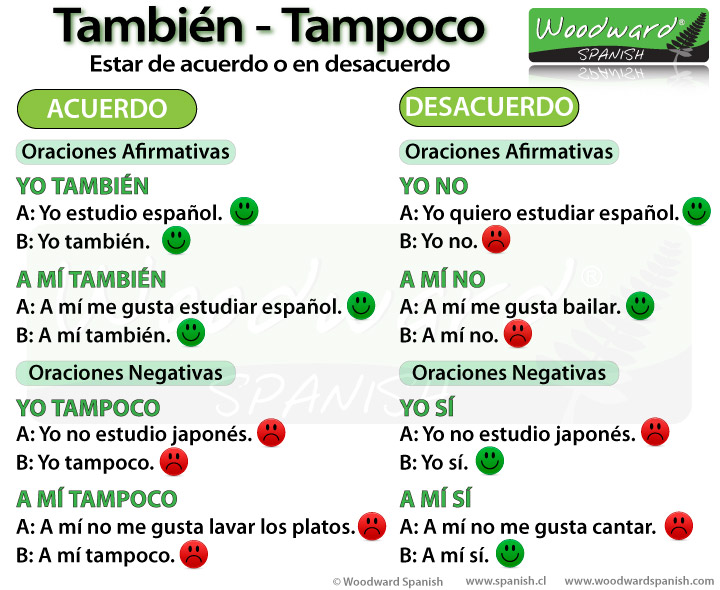También vs Tampoco
Spanish Grammar Rules
Simple explanation of También vs Tampoco
Both También and Tampoco are used when you are agreeing with what someone says or to show that you do the same thing or feel the same way.
- We use también to show agreement with a positive statement.
- We use tampoco to show agreement with a negative statement.
También
También can have the meaning of TOO or ALSO in English depending on where the word is positioned.
See the following example using También.
- Diego: Yo estudio español.
Daniel: Yo también.
Here Diego says "Yo estudio español" (I study Spanish). Daniel says "Yo también" (me too) because he is confirming that he does the same thing.
Why do you use También and not Tampoco? Because Diego's statement is positive/affirmative.
Tampoco
But what happens if Diego doesn't study Spanish and neither does Daniel? The conversation would be the following:
- Diego: Yo no estudio español.
Daniel: Yo tampoco.
Here Diego says "Yo NO estudio español" (I don't study Spanish) which is a negative statement. Since Daniel doesn't study Spanish either, he agrees with Diego's statement and says "Yo tampoco" (me neither) because he is confirming that he doesn't do the same thing.
Tampoco can have the meaning of NEITHER or EITHER in English depending on where the word is positioned.
Example sentences using También and Tampoco
A: Yo hablo inglés.
B: Yo también (hablo inglés).
A: Yo vivo en un departamento chico.
B: Yo también.
A: María no habla portugués
B: Yo tampoco.
A: Ellos no quieren hacer sus tareas.
B: Nosotros tampoco.
Note that también and tampoco can be used with any person (or subject pronoun).
- Yo también, tú también, él también, mi amigo también... etc.
También and Tampoco with the verb Gustar
When you agree with a statement that contains the verb Gustar (Like), the beginning of the sentence changes. Instead of YO we use A MÍ. The same happens with the other subjects, TÚ becomes A TÍ etc. (See our notes about making sentences with the verb Gustar - coming soon)
Diego: A mí me gusta el chocolate.
Daniel: A mí también. (We don't say "Yo también")
Diego: A mí me gustan los perros.
Daniel: A mí también.
Diego: A mí no me gustan las arañas.
Daniel: A mí tampoco.
Diego: A Pedro no le gusta bailar.
Daniel: A mí tampoco.
Disagreeing with someone in Spanish
But what happens if you don't agree with what the person has said or you don't do the same thing as that person.
If Diego says "Yo hablo francés" (I speak French) and you don't speak it you can't use también nor tampoco because you don't do the same as that person. We simply say Yo no or if the verb Gustar is used, A mí no.
Diego: Yo hablo francés.
You: Yo no.
Diego: A mí me gusta el arroz.
You: A mí no
And the same happens if the person doesn't do or like something but you do. We simply say Yo sí or if the verb Gustar is used, A mí sí.
Diego: Yo no hablo inglés.
You: Yo sí.
Diego: A mí no me gusta el arroz.
You: A mí sí.
También - Tampoco - Yo Sí - Yo No - Summary Chart

Next Activities
Try our game about the difference between También and Tampoco.
Ver nuestra explicación de la diferencia entre También y Tampoco en español.
Para Profesores y Padres
If you found this guide about the difference between También and Tampoco useful, let others know about it.


